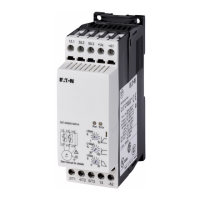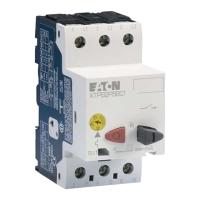2. Programming Concepts
MN05003003E For more information visit: www.eaton.com
2-103
Function
M1133
Y10 outputs starting flag for two-axis synchronous control
M1135
Y11 outputs starting flag for two-axis synchronous control
D1133 Y10 outputs the starting number of register (D) for two-axis synchronous control
D1134 Set the number of segments of Y10 output for two-axis synchronous control
D1135 Y11 outputs the starting number of register (D) for two-axis synchronous control
D1136 Set the number of segments of Y11 output for two-axis synchronous control
2. D1133~D1135 parameters:
Index Function
+0
Y10, Y11 two-axis synchronous control; output frequency of 1
st
segment = low
16 bits of 32 bits
+1
Y10, Y11 two-axis synchronous control; output frequency of 1
st
segment = high
16 bits of 32 bits
+2
Y10, Y11 two-axis synchronous control; output pulse number of 1
st
segment =
low 16 bits of 32 bits
+3
Y10, Y11 two-axis synchronous control; output pulse number of 1
st
segment =
high 16 bits of 32 bits
Function explanation:
1. Definition of the two axes:
X axis Æ Y0 (direction output) and Y10 (pulse output)
Y axis Æ Y1 (direction output) and Y11 (pulse output)
2. Define the format of output table:
Assume D1133 = K100 and D1134 = K3 and the output table has to be set as:
Segment D
Output
frequency
D
Output pulse
number
Description
1 D101,D100 K10000 D103,D102 K1000
Segment 1 outputs 1,000
pulses by 10KHz
2 D105,D104 K15000 D107,D106 K2000
Segment 2 outputs 2,000
pulses by 15KHz
3 D109,D108 K5000 D111,D110 K3000
Segment 3 outputs 3,000
pulses by 5KHz
Remarks: The frequency and number of outputs are all 32-bit. Thus, the 3 segments
continuously occupy 12 registers D (3x2x2=12).
Note:
1. Make sure that the output frequency and pulse number have been set before using this
function. The output frequency and pulse number cannot be modified during operation.

